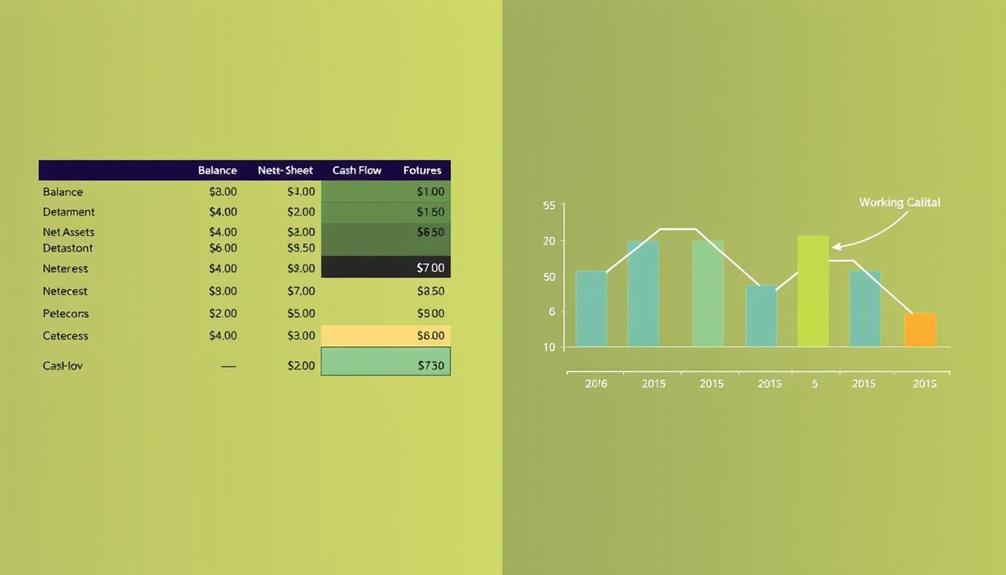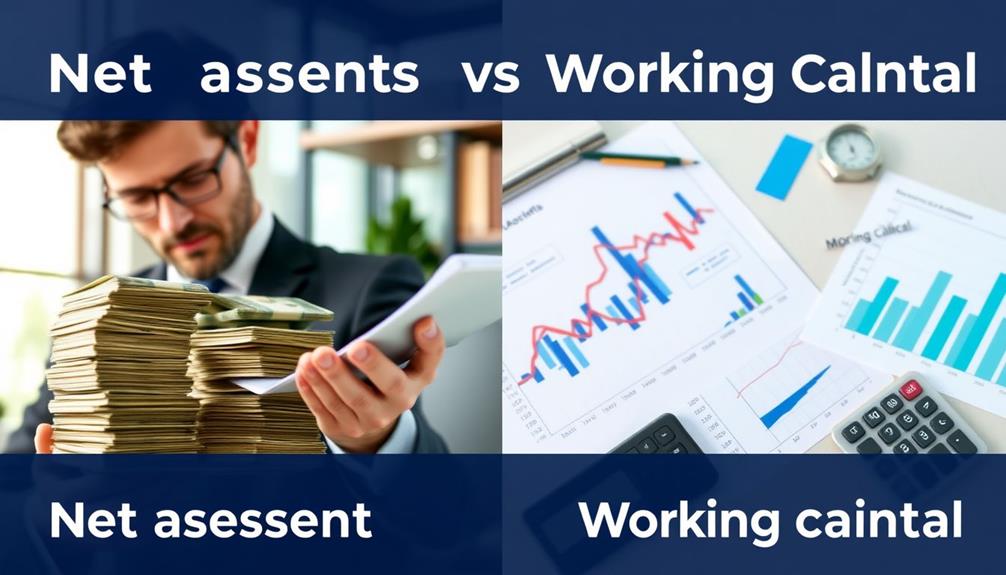When you're evaluating a company's financial health, understanding the difference between net assets and working capital is essential. Net assets, calculated as total assets minus total liabilities, indicate long-term stability and overall equity position. In contrast, working capital measures your ability to manage short-term obligations, focusing on current assets and liabilities. While net assets give a big-picture view, working capital reveals daily operational liquidity. Balancing these metrics is vital for sustainable growth and cash flow management. Stay tuned to explore how optimizing both can transform your financial strategies!
Key Takeaways
- Net assets provide a comprehensive view of a company's overall financial health, while working capital focuses on short-term liquidity.
- Positive net assets indicate long-term financial stability, whereas positive working capital highlights the ability to cover immediate obligations.
- Net assets include both current and non-current assets, while working capital is limited to current assets and liabilities.
- Monitoring working capital is crucial for operational efficiency, but understanding net assets is essential for long-term resilience.
- Balancing both metrics is vital for sustainable growth, cash flow management, and overall financial strategy.
Understanding Net Assets
Understanding net assets is essential for evaluating a company's financial health. Net assets are calculated by subtracting total liabilities from total assets, offering a clear snapshot of a company's financial position. This figure encompasses both current and non-current assets, including cash, accounts receivable, inventory, and property, while accounting for both short-term and long-term obligations.
A solid grasp of common financial terms can further enhance your understanding of net assets and their implications.
A positive net asset value is critical for evaluating a company's solvency. It indicates that the company's assets exceed its liabilities, suggesting that the business can meet its financial obligations. Investors often rely on this metric to gauge the value of a company's equity in relation to its debts.
On the flip side, a negative net asset value may raise red flags about financial stability and operational viability, prompting deeper scrutiny.
Unlike working capital, which focuses only on current assets and liabilities, net assets provide a more thorough view of a company's overall financial health. By understanding net assets, you can better appreciate how well a company is positioned to navigate both short-term challenges and long-term goals.
This insight is essential for making informed investment decisions.
The Significance of Working Capital

In the domain of business finance, working capital is an important indicator of a company's short-term liquidity and operational efficiency. It's calculated as current assets minus current liabilities, giving you a clear view of your financial health. A positive working capital means you can cover your short-term obligations, while negative working capital could suggest looming liquidity issues.
Regularly monitoring your working capital is vital for maintaining operational efficiency. It allows you to assess your ability to support ongoing operations and seize growth opportunities. However, keep in mind that high working capital isn't always a win; it might indicate excess inventory or uninvested cash, which can hinder ideal resource allocation.
To further understand your liquidity position, you can look at the current ratio, derived from dividing current assets by current liabilities. A ratio above 1 generally signals good financial health.
| Aspect | Description |
|---|---|
| Working Capital | Current assets minus current liabilities |
| Positive Working Capital | Indicates ability to cover short-term obligations |
| Current Ratio | Current assets divided by current liabilities |
| Operational Efficiency | Ability to manage cash flow effectively |
| Liquidity | Measure of cash availability for immediate needs |
Key Differences Between Metrics

When comparing net assets and working capital, it's essential to recognize that each metric offers a unique perspective on a company's financial health. Net assets represent the total assets minus total liabilities, giving you a snapshot of the company's equity position.
In contrast, working capital measures the difference between current assets and current liabilities, focusing on the company's ability to meet short-term obligations. Understanding financial advisor insights can provide additional context for evaluating these metrics effectively.
A positive net asset value indicates that a company's assets exceed its liabilities, reflecting long-term stability. Meanwhile, positive working capital signifies that current assets are enough to cover current liabilities, underlining operational liquidity and cash flow efficiency.
While net assets can include long-term investments and fixed assets, working capital zeroes in on assets and liabilities due within one year. This distinction is significant for your financial analysis. While net assets provide a broader view of a company’s overall value, working capital focuses on short-term financial health and liquidity. By comparing current assets and liabilities, it allows businesses to assess their ability to cover immediate obligations. In scenarios where liabilities exceed assets, it can lead to a situation often labeled as “net worth reaching zero explained,” highlighting the critical need for balanced financial management to avoid operational disruptions.
Net assets provide insights into the total value of the company, whereas working capital reveals how well the company can manage its day-to-day operations.
Understanding these key differences empowers you to assess a company's financial health more accurately, allowing for better-informed decisions regarding investments and resource allocation.
Implications for Financial Analysis

Evaluating the implications of net assets and working capital reveals significant insights for financial analysis. Understanding these two metrics is essential for determining a company's financial health.
Working capital, calculated as current assets minus current liabilities, indicates your ability to meet short-term obligations and manage liquidity. A positive working capital suggests you can cover immediate debts, ensuring smooth operations. In a volatile economy, maintaining a strong working capital can also serve as a buffer against unexpected financial downturns, similar to how gold IRAs can protect against inflation and market downturns.
On the other hand, net assets provide a broader perspective, reflecting the total assets minus total liabilities. This metric highlights your long-term financial resilience. Even if your working capital is low due to high current liabilities, strong net assets can still signal stability to investors.
Financial analysts often focus on working capital ratios, like the current ratio, to gauge liquidity. However, neglecting net assets can lead to an incomplete picture of your company's overall financial position.
Investors need to understand that a robust net asset position mightn't offset poor working capital management. This imbalance can lead to liquidity crises, jeopardizing cash flow and operational efficiency.
Therefore, balancing both metrics is essential for a thorough financial analysis and ensuring sustainable growth.
Strategies for Improvement

Balancing net assets and working capital is key to achieving financial stability, but there are practical strategies you can implement to enhance these metrics. By focusing on the following areas, you can markedly improve your cash flow and overall financial health:
1. Optimize Inventory Management: Maintain appropriate levels of current assets to minimize cash tied up in excess stock. This can reduce holding costs by 20-30%.
Additionally, using data-driven strategies can help you make informed decisions about inventory turnover and demand forecasting.
2. Enhance Accounts Receivable: Negotiate shorter payment terms with customers and implement effective collection strategies to potentially increase available cash by up to 15% within a year.
This can also create a more engaging customer experience, leading to stronger relationships and repeat business.
3. Maximize Accounts Payable: Extend payment terms with suppliers to retain cash longer, thereby improving your working capital without damaging supplier relationships.
This strategic approach can also provide flexibility in managing unforeseen expenses.
4. Regularly Analyze Metrics: Keep an eye on key working capital metrics like the current ratio and net working capital to identify trends and make proactive adjustments to your financial strategies.
Regular analysis guarantees you stay ahead of potential cash flow issues and can capitalize on emerging opportunities.
Incorporating these strategies not only boosts cash flow but also strengthens your brand's reputation and long-term viability.
Conclusion
In the world of finance, net assets and working capital serve different purposes, yet both are vital to your business's health. While net assets reflect your overall worth, working capital reveals your day-to-day financial agility. Ignoring these distinctions can lead to costly miscalculations. So, don't let the million-dollar difference slip through your fingers—understand how to leverage both metrics effectively. With the right strategies, you can guarantee your business not only survives but thrives.










